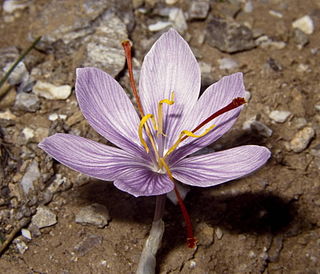
Crocus cartwrightianus is a species of flowering plant in the family Iridaceae. It is native to mainland Greece, Euboea, Crete, Skyros and some islands of the Cyclades. It is a cormous perennial growing to 5 cm (2 in). The flowers, in shades of lilac or white with purple veins and prominent red stigmas, appear with the leaves in autumn and winter.

Scilla luciliae is a species of flowering plant in the family Asparagaceae. It is referred to by the common names Bossier's glory-of-the-snow or Lucile's glory-of-the-snow, and is a bulbous perennial from western Turkey that flowers in early spring. After flowering, it goes into dormancy until the next spring. The specific epithet is in honour of Lucile, the wife of the Swiss botanist Pierre Edmond Boissier (1810-1885). It belongs to a group of Scilla species that were formerly put in a separate genus, Chionodoxa, and may now be treated as Scilla sect. Chionodoxa.

Geranium pratense, the meadow crane's-bill or meadow geranium, is a species of flowering plant in the family Geraniaceae, native to Europe and Asia. Forming a clump up to 1 m (3.3 ft) broad, it is a herbaceous perennial with hairy stems and lax saucer-shaped blooms of pale violet. It is extremely hardy to at least −20 °C (−4 °F), reflecting its origins in the Altai Mountains of central Asia.

Crocus banaticus, is a species of flowering plant in the family Iridaceae. It is native to the Balkans, particularly in Serbia, Romania and south western Ukraine. It creates its own subgenus in the Crocus subfamily known as Crociris. It is a cormous perennial growing to 10 cm (4 in).

Crocus chrysanthus, the snow crocus or golden crocus, is a species of flowering plant in the family Iridaceae. It is Native to the Balkans and Turkey, it bears vivid orange-yellow bowl-shaped flowers. It has smaller corms and a smaller flower than the giant Dutch crocus, although it produces more flowers per corm than the latter. Its common name, "snow crocus", derives from its exceptionally early flowering period, blooming about two weeks before the giant crocus, and often emerging through the snow in late winter or early spring. The leaves are narrow with a silver central stripe. Height: 3–4 inches (7.6–10.2 cm).
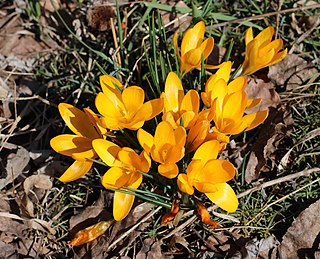
Crocus flavus, known as yellow crocus, Dutch yellow crocus or snow crocus, is a species of flowering plant in the genus Crocus of the family Iridaceae. It grows wild on the slopes of Greece, former Yugoslavia, Bulgaria, Romania and northwestern Turkey, with fragrant bright orange-yellow flowers. It is a small crocus (5–6 cm, despite the names of some cultivars, compared to the giant Dutch crocuses. Its cultivars are used as ornamental plants.

Crocus sieberi, Sieber's crocus, also referred to as the Cretan crocus or snow crocus, is a plant of the genus Crocus in the family Iridaceae. A small, early blooming crocus, it easily naturalises, and is marked by a brilliant orange which is mostly confined to the stamens and style, fading through the bottom third of the tepal. It grows wild generally in the Balkans: Greece, especially in the island of Crete, Bulgaria, Albania and North Macedonia. There are four subtypes: sieberi (Crete), atticus, nivalis and sublimis. Its cultivars are used as ornamental plants. Height: 3–4 inches (7.6–10.2 cm).

Colchicum cilicicum, the Tenore autumn crocus, is a species of flowering plant in the family Colchicaceae. A bulbous perennial, it bears deep rose-lilac flowers in late summer, with barely any chequered pattern on the petals (tessellation). It has a very noticeable white stripe down the centre of each petal, which gives it a star-like appearance at the base. The flowers tend to stand up to weather better than other colchicum blooms. The flowers appear before the strap-like leaves, giving this and other colchicum species the common name "naked lady". Although colchicums are called "autumn crocuses" they belong to a different family than true crocuses. There are in fact autumn-flowering species of crocus such as Crocus sativus, which is the source of the spice saffron. Colchicum cilicicum, by contrast, is toxic if eaten.

Crocus biflorus, the silvery crocus or scotch crocus, is a species of flowering plant in the family Iridaceae. It is native to south-eastern Europe and south-western Asia, including Italy, the Balkans, Ukraine, Turkey, Caucasus, Iraq, and Iran. It is a cormous perennial growing to 6 cm (2.4 in) tall and wide. It is a highly variable species, with flowers in shades of pale mauve or white, often with darker stripes on the outer tepals. The flowers appear early in spring.

Crocus corsicus is a species of flowering plant in the genus Crocus of the family Iridaceae, endemic to the Mediterranean islands of Corsica and Sardinia.

Crocus etruscus is a species of flowering plant in the genus Crocus of the family Iridaceae, endemic to woodlands of Central Tuscany (Italy). It is a cormous perennial growing to 8 cm (3.1 in) tall. The lilac flowers with purple veining and prominent orange stigmas appear in early spring.
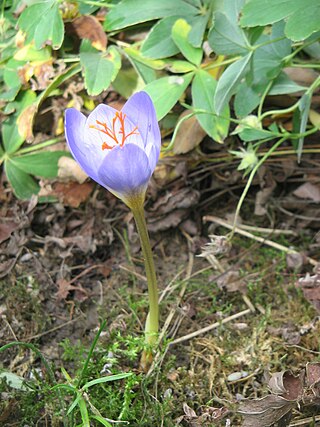
Crocus pulchellus, the hairy crocus is a species of flowering plant in the family Iridaceae. It is found the Northern Balkan Peninsula to Northwestern Turkey.
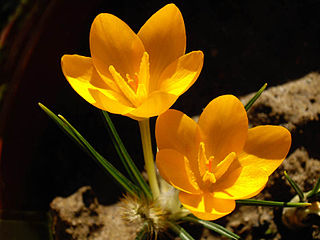
Crocus ancyrensis, sometimes known as the Ankara crocus, is a species of flowering plant in the family Iridaceae. It is endemic to North and Central Turkey. It was named ancyrensis as it was first discovered in Ankara.

Crocus cancellatus is a species of flowering plant in the family (biology Iridaceae. It is found from the Balkan Peninsula to Iran.

Crocus caspius is a species of flowering plant in the genus Crocus of the family Iridaceae, from Southeastern Transcaucasus to Northern Iran.

Crocus kotschyanus, Kotschy's crocus, is a species of flowering plant in the genus Crocus of the family Iridaceae, found from Turkey to Caucasus and Lebanon.

Crocus laevigatus, the smooth crocus, is a species of flowering plant in the genus Crocus of the family Iridaceae, endemic to Crete, Greece.

Crocus longiflorus, the long-flowered crocus, is a species of flowering plant in the genus Crocus of the family Iridaceae, found in Southwest Italy, Sicilia, and Malta.

Crocus nudiflorus is a species of flowering plant in the genus Crocus of the family Iridaceae. It is an autumn-flowering, dwarf, deciduous perennial found in western Europe from southwestern France to Spain. It has been cultivated since Tudor times in Great Britain, where it is now naturalized.
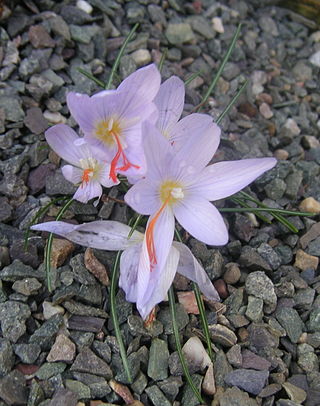
Crocus tournefortii, the Tournefort crocus, is a species of flowering plant in the iris family Iridaceae. It is from South Greece and Northern Crete.





















